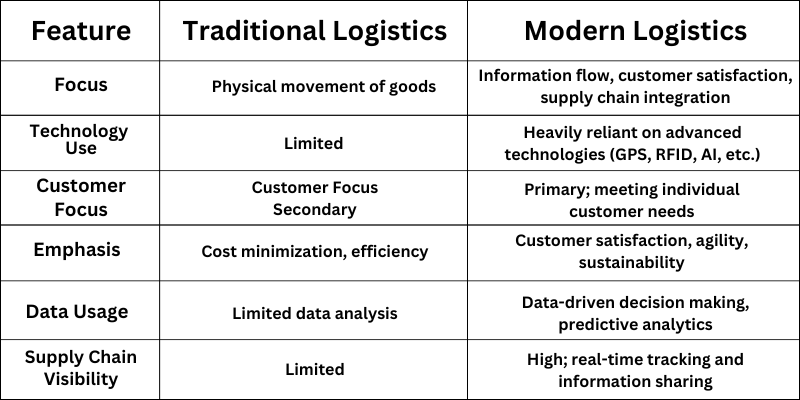
If you are interested in beginning your career in logistics, this blog presents you insights about the whole industry of logistics, its types namely traditional or forward logistics and modern logistics and how they differ from each other. Read further to know the operations involved in logistics and its impact in various businesses.
How Logistics has Evolved?
Logistics has undergone a dramatic transformation, evolving from basic transportation and storage to a sophisticated, technology-driven field. Initially focused on simply moving goods, logistics has evolved to encompass intricate supply chain management, emphasizing efficiency, customer satisfaction, and sustainability. Technological advancements, such as GPS tracking, RFID technology, and AI-powered analytics, have revolutionized how goods are moved, stored, and tracked. The rise of e-commerce has further accelerated this evolution, demanding faster, more flexible, and often same-day delivery options. Modern logistics now prioritizes data-driven decision-making, customer-centric approaches, and sustainable practices, aiming to create seamless and effective supply chains that meet the demands of a globalized and increasingly complex marketplace.
Traditional Logistics Processes
Traditional logistics, also known as forward logistics methods, refers to the process of moving goods from their source place to their final destination. There are a lot of important activities involved during this transportation like that of procurement, production, warehousing, transportation, and distribution. Procurement entails sourcing and purchasing raw materials or finished goods, whereas production involves manufacturing or assembling several products together to make one. Once goods are produced, they are stored in warehouses or distribution centers at different parts of the country. Boston College offers degree courses to learn logistics.
They are then transported to their destinations using different transport modes, including trucks, trains, ships, and aeroplanes. The primary focus of traditional logistics is on efficiency, aiming to move goods as quickly and cost-effectively as possible, with a great emphasis on the physical flow of products. Although you can see the use of technology within this framework, its application is often limited compared to the modern logistics practices.
Modern Logistics Systems
Modern logistics represents a significant change from traditional approaches, and is characterized by a strong focus on information flow and real-time data exchange across the entire supply chain. We use modern technologies in the process of logistics. Technologies such as GPS for tracking shipments, RFID for automatic identification, blockchain for secure record-keeping, cloud computing for data storage and analysis, and AI for conducting predictive analytics play a crucial role in this transformation. In modern logistics, a customer-centric approach is given maximum importance, with priorities including on-time delivery, order accuracy, supply chain visibility, and personalized service. All the parties involved in the above-mentioned processes are interconnected. They promote collaboration and information sharing among suppliers, manufacturers, distributors, and customers to optimize efficiency and responsiveness. Modern logistics also focuses on sustainability. It emphasizes on reducing carbon emissions, minimizing waste, and promoting ethical labour practices, thereby incorporating environmental and social responsibility into its operations.
Traditional Logistics Vs Modern Logistics
Traditional Logistics
-
Key Activities: Procurement, production, warehousing, transportation, distribution.
Modern Logistics
-
Key Activities: Similar to traditional, but with a stronger emphasis on data analysis, predictive modeling, and customer relationship management.
-
Technology Use: Heavily reliant on technology: GPS, RFID, AI, cloud computing, blockchain.
While traditional logistics remains a fundamental part of many businesses, the increasing complexity of supply chains and the demand for quicker and more efficient delivery have led to the evolution of modern logistics. Hotel Management related degree programs also enable you to learn logistics and its types in depth.
Traditional Logistics Management
Aim: Primarily on the physical movement of goods.
Key Activities:
Technology Use: Limited; often relying on manual processes, spreadsheets, and basic tracking systems.
Emphasis:
Customer Focus: Secondary; less emphasis on individual customer needs.
Modern Logistics Management
Focus:
Key Activities: All traditional activities, plus:
Technology Use: Heavily reliant on:
GPS: Real-time tracking of shipments
RFID: Automatic identification and data capture
AI & Machine Learning: Predictive analytics, demand forecasting, route optimization
Cloud Computing: Data storage, analysis, and collaboration
Blockchain: Secure and transparent record-keeping
Emphasis:
Here's a table of Logistics technology comparison

In conclusion, the evolution of logistics from a focus on mere transportation to a modern, technology-driven approach highlights its critical role in today's supply chain management. BBA Logistics and Shipping is a degree program where you will learn both these types of logistics in detail. While traditional logistics aimed to efficiently move goods from point A to point B, contemporary practices now harness the power of data and technology to create a customer-centric and responsive framework. This shift not only addresses the changing demands of the market but also emphasizes sustainability, ensuring that businesses can thrive successfully. By embracing these advancements, companies can better meet the customer needs and contribute to a more sustainable future.